Oxy-fuel combustion oxidant heater internal arrangement
a combustion oxidant and heater technology, applied in the direction of indirect heat exchangers, combustion types, lighting and heating apparatus, etc., can solve the problems of 14% leakage of oxidant into the ga, inherent leakage between the air (or oxidant) side, and leakage from the oxidant to the gas side, so as to reduce the overall power plant operating cost, minimize the loss of costly oxygen, and cost-effective
- Summary
- Abstract
- Description
- Claims
- Application Information
AI Technical Summary
Benefits of technology
Problems solved by technology
Method used
Image
Examples
Embodiment Construction
[0040]The present invention relates to a system and method designed for use in oxy-fuel combustion where a regenerative oxidant heater is desired, and it incorporates a novel regenerative oxidant heater internal sector arrangement as well as the strategic positioning of both a primary oxidant fan and primary oxidant mixer.
[0041]The system and method of the present invention, among other things, minimizes loss of oxygen to the boiler flue gas stream and simultaneously provides a sufficient amount of cool oxidant flow to the oxidant heater so that a reasonable heat exchange within the oxidant heater and a reasonable oxidant heater exit gas temperature can be achieved. Furthermore, the system and method of the present invention accomplish this, in part, by employing and oxidant heater internal sector arrangement which can allow a substantial amount of internal leakage from a cold primary combustion oxidant stream to both a flue gas stream and a secondary combustion oxidant stream.
[0042...
PUM
 Login to View More
Login to View More Abstract
Description
Claims
Application Information
 Login to View More
Login to View More - R&D
- Intellectual Property
- Life Sciences
- Materials
- Tech Scout
- Unparalleled Data Quality
- Higher Quality Content
- 60% Fewer Hallucinations
Browse by: Latest US Patents, China's latest patents, Technical Efficacy Thesaurus, Application Domain, Technology Topic, Popular Technical Reports.
© 2025 PatSnap. All rights reserved.Legal|Privacy policy|Modern Slavery Act Transparency Statement|Sitemap|About US| Contact US: help@patsnap.com



